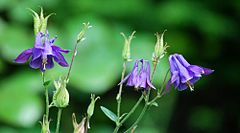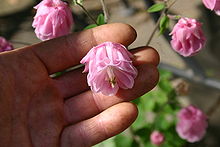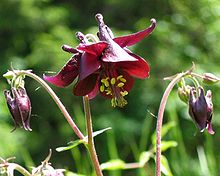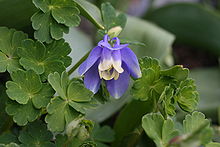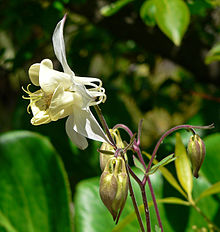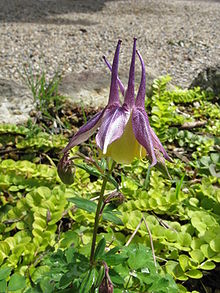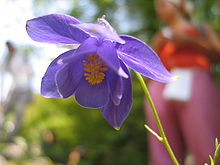- Aquilegia
-
For other uses, see Aquilegia (disambiguation).
Columbines flower and fruit of Aquilegia vulgaris (type species) Scientific classification Kingdom: Plantae Division: Magnoliophyta Class: Magnoliopsida (unranked): Eudicots Order: Ranunculales Family: Ranunculaceae Subfamily: Thalictroideae Genus: Aquilegia
L.Species 60-70, see text
Aquilegia (Columbine; from Latin columba "dove") is a genus of about 60-70 species[1] of perennial plants that are found in meadows, woodlands, and at higher altitudes throughout the Northern Hemisphere, known for the spurred petals [2] of their flowers.
Contents
Etymology
The genus name Aquilegia is derived from the Latin word for eagle (aquila), because the shape of the flower petals are said to resemble an eagle's claw.
"Columbine" is derived from the Latin word for pigeon (columba).
Description
Relatives
Columbines are closely related to plants in the genera Actaea (baneberries) and Aconitum (wolfsbanes/monkshoods), which like Aquilegia produce cardiogenic toxins.[4]
Insects
They are used as food plants by some Lepidoptera (butterflies and moths) caterpillars. These are mainly of noctuid moths – noted for feeding on many poisonous plants without harm – like Cabbage Moth (Mamestra brassicae), Dot Moth (Melanchra persicariae) and Mouse Moth (Amphipyra tragopoginis). The Engrailed (Ectropis crepuscularia), a geometer moth, also uses columbine as larval foodplant.
Cultivation
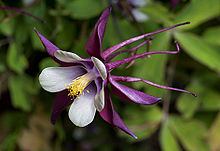 Columbine cultivar 'Magpie'
Columbine cultivar 'Magpie' Double-flowered Aquilegia × hybrida
Double-flowered Aquilegia × hybrida
Several species are grown in gardens, including the European Columbine (A. vulgaris), a traditional garden flower in many parts of the world.[5] Numerous cultivars and hybrids have also been developed as well. They are easy to propagate from seed.
Columbine is a perennial, which propagates by seed. It will grow to a height of 15 to 20 inches. It will grow in full sun, however, prefers growing in partial shade and well drained soil, and is able to tolerate average soils and dry soil conditions. Columbine is rated hardiness of Zone 3 so does not require mulching or protection in the winter.[6][7]
Large numbers of hybrids are now available for the garden, since the British A vulgaris was joined by other European and N American varieties. [8] Aquilegia species are very interfertile, and will self sow.[9]
Uses
The flowers of various species of Colombine were consumed in moderation by Native Americans as a condiment with other fresh greens, and are reported to be very sweet, and safe if consumed in small quantities. The plant's seeds and roots are highly poisonous however, and contain cardiogenic toxins which cause both severe gastroenteritis and heart palpitations if consumed as food. Native Americans used very small amounts of Aquilegia root as an effective treatment for ulcers. However, the medical use of this plant is better avoided due to its high toxicity; columbine poisonings may be fatal.[4]
Culture
The Colorado Blue Columbine (A. caerulea) is the official state flower of Colorado (see also Columbine, Colorado).
Evolution
Columbines have been important in the study of evolution. It was found that Sierra Columbine (A. pubescens) and Crimson Columbine (A. formosa) each have specifically adapted pollinators, with hawkmoths that can pollinate one species while usually failing to pollinate the other. Such a "pollination syndrome", being due to flower genetics, ensures reproductive isolation and can be a cause of underlying speciation.[10]
Petal Spur Evolution
Aquilegia petals show an enormous range of petal spur length diversity ranging from a centimeter to the 15 cm spurs of Aquilegia longissima. Interestingly, it was shown that this amazing spur length diversity is achieved solely through changing cell shape, not cell number or cell size. This suggests that a simple microscopic change can result in a dramatic evolutionarily relevant morphological change. [11]
Species
Columbine species include:[12]
- Aquilegia alpina L.
- Aquilegia atrata W.D.J.Koch
Dark Columbine - Aquilegia atrovinosa
- Aquilegia aurea Janka
- Aquilegia barbaricina
Barbaricina Colombine (doubtfully valid) - Aquilegia barnebyi
Oil Shale Columbine - Aquilegia bernardii Gren. & Godr.
- Aquilegia bertolonii Schott
- Aquilegia blecicii Podobnik (doubtfully valid)
- Aquilegia brevistyla
Smallflower Columbine - Aquilegia buergeriana
- Aquilegia caerulea
Colorado Blue Columbine - Aquilegia canadensis
Canadian Columbine, Wild Columbine - Aquilegia champagnatii Moraldo, E.Nardi & la Valva (doubtfully valid)
- Aquilegia chrysantha
Golden Columbine - Aquilegia desertorum
Desert Columbine - Aquilegia desolatica
Desolation Columbine - Aquilegia dinarica Beck
- Aquilegia ecalcarata
- Aquilegia einseleana F.W.Schultz
- Aquilegia elegantula
Western Red Columbine - Aquilegia eximia
Van Houtte's Columbine - Aquilegia flabellata
Fan Columbine, Japanese wodamakinari (including A. akitensis) - Aquilegia flavescens
Yellow Columbine - Aquilegia fragrans Benth.
Fragrant Columbine - Aquilegia formosa
Crimson Columbine, Western Columbine - Aquilegia glandulosa
- Aquilegia grahamii
Graham's Columbine - Aquilegia grata
- Aquilegia × hybrida
- Aquilegia incurvata
- Aquilegia japonica
- Aquilegia jonesii
Jones' Columbine
- Aquilegia karatavica
- Aquilegia karelini
- Aquilegia kitaibelii Schott
- Aquilegia lactiflora
- Aquilegia laramiensis
Laramie Columbine - Aquilegia litardierei Briq.
- Aquilegia longissima
Gray. Longspur Columbine - Aquilegia loriae
Lori's Columbine - Aquilegia magellensis F.Conti & Soldano
Magella Columbine - Aquilegia × maruyamana
- Aquilegia micrantha
Mancos Columbine - Aquilegia moorcroftiana
- Aquilegia nigricans Baumg.
- Aquilegia nugorensis Arrigoni & E.Nardi (doubtfully valid)
- Aquilegia nuragica
- Aquilegia olympica
- Aquilegia origami
- Aquilegia ottonis Orph. ex Boiss.
- Aquilegia oxysepala
- Aquilegia pancicii Degen
- Aquilegia parviflora
- Aquilegia pubescens
Sierra Columbine, Coville's Columbine - Aquilegia pubiflora
- Aquilegia pyrenaica DC.
Pyrenean Columbine - Aquilegia rockii
- Aquilegia saximontana
Rocky Mountain Columbine - Aquilegia scopulorum
Blue Columbine, Utah Columbine - Aquilegia shockleyi
Desert Columbine - Aquilegia sibirica
- Aquilegia thalictrifolia Schott & Kotschy
- Aquilegia transsilvanica Schur
- Aquilegia triternata
Chiricahua Mountain Columbine - Aquilegia truncata Red Columbine
- Aquilegia turczaninovii
- Aquilegia viridiflora
- Aquilegia viscosa Gouan
- Aquilegia vitalii
- Aquilegia vulgaris
Common Columbine, European Columbine, Granny's Nightcap - Aquilegia yabeana
See also
Footnotes
- ^ Sunset Western Garden Book, 1995:606–607
- ^ Puzey, J.R., Gerbode, S.J., Hodges, S.A., Kramer, E.M., Mahadevan, L. (2011) Evolution of Aquilegia spur length diversity through changes in cell anisotropy. Proceedings of the Royal Society B.
- ^ Dezhi & Robinson (2001)
- ^ a b Tilford (1997)
- ^ Nold (2003): p.128
- ^ http://www.gardenersnet.com/flower/columbine.htm The Gardener's Network
- ^ John Kilmer (1989). The Perennial Encyclopedia ISBN 0886656397
- ^ Andrew McIndoe, Kevin Hobbs: Perennials. David & Charles, 2005 ISBN 1558707646, 9781558707641
- ^ New England Wild Flower Society Guide to Growing and Propagating Wildflowers of the United States and Canada
- ^ Fulton & Hodges (1999), Hodges et al. (2002)
- ^ Puzey, J.R., Gerbode, S.J., Hodges, S.A., Kramer, E.M., Mahadevan, L. (2011) Evolution of Aquilegia spur length diversity through changes in cell anisotropy. Proceedings of the Royal Society B.
- ^ Dezhi & Robinson (2001), RBGE [2008], USDA [2008]
References
- Allan M. Armitage: Armitage's Native Plants for North American Gardens.Timber Press, 2006 ISBN 0881927600, 9780881927603
- Dezhi, Fu; Robinson, Orbélia R. (2001): 19. Aquilegia. In: Wu, Z. Y.; Raven, Peter Hamilton & Hong, D.Y. (eds.): Flora of China (Vol. 6: Caryophyllaceae through Lardizabalaceae): 278. Science Press, Beijing & Missouri Botanical Garden Press, St. Louis. ISBN 1-930723-25-3 HTML fulltext
- Fulton, M.; Hodges, S. A. (1999). "Floral isolation between Aquilegia formosa and Aquilegia pubescens". Proceedings of the Royal Society B: Biological Sciences 266 (1435): 2247–2252. doi:10.1098/rspb.1999.0915.
- Hodges, S. A.; Whittall, J. B.; Fulton, M.; Yang, J. Y. (2002). "Genetics of Floral Traits Influencing Reproductive Isolation betweenAquilegia formosaandAquilegia pubescens". The American Naturalist 159: S51–S60. doi:10.1086/338372. PMID 18707369.
- Nold, Robert (2003): Columbines: Aquilegia, Paraquilegia, and Semiaquilegia. Timber Press. ISBN 0881925888 Preview at Google Books
- Royal Botanic Garden Edinburgh (RBGE) [2008]: Digital Flora Europaea: Aquilegia species list. Retrieved 2008-NOV-25.
- Tilford, Gregory L. (1997): Edible and Medicinal Plants of the West. Mountain Press Pub., Missoula, Montana. ISBN 0-87842-359-1
- United States Department of Agriculture (USDA) [2008]: USDA Plants Profile: Aquilegia. Retrieved 2008-NOV-25.
- Puzey, J. R.; Gerbode, S. J.; Hodges, S. A.; Kramer, E. M.; Mahadevan, L. (2011). "Evolution of spur-length diversity in Aquilegia petals is achieved solely through cell-shape anisotropy". Proceedings of the Royal Society B: Biological Sciences. doi:10.1098/rspb.2011.1873.
Related Reading
- Kramer, EM. (2009). Aquilegia: A New Model for Plant Development, Ecology, and Evolution Annual Review of Plant Biology, Vol. 60.
Categories:- Ranunculaceae genera
Wikimedia Foundation. 2010.

